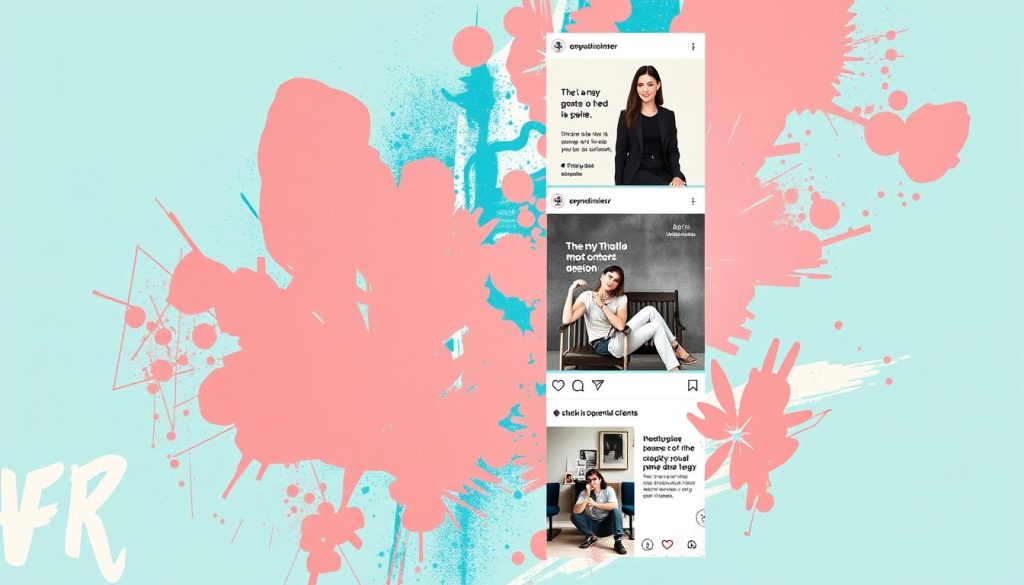As a freelancer, having a strong online presence is crucial in today’s digital landscape. But are you leveraging social media effectively to grow your business and attract high-quality clients?
Establishing a professional brand on platforms like LinkedIn can significantly enhance your visibility and credibility. In fact, a significant percentage of freelancers have reported success in obtaining new clients through these channels. To learn more about building a strong personal brand, check out our guide on boosting your personal branding.
By optimizing your online presence and creating a cohesive visual identity, you can increase your chances of attracting your ideal clients. This comprehensive guide will walk you through the process of developing a tailored social media strategy for your freelance business.
Table of Contents
Key Takeaways
- Understand the importance of social media for your freelance business
- Learn how to create a professional online presence
- Discover strategies for engaging with potential clients on social media platforms
- Find out how to measure the success of your online efforts
- Develop a sustainable social media strategy tailored to your needs
Why Social Media Matters for Your Freelance Business
With over half of the global population on social media, freelancers have a unique opportunity to connect with potential clients and grow their freelance business. An effective social media strategy can help expand your professional network and attract lucrative clients.
The Power of Online Presence in Freelancing
A strong online presence is crucial for establishing credibility and showcasing your expertise to potential clients. By leveraging social media, you can demonstrate your technical skills and communication abilities, making you more attractive to prospective clients.
Setting Clear Goals for Your Social Media Strategy
To maximize the benefits of social media, it’s essential to set specific, measurable goals. Whether you aim to build awareness, generate leads, or nurture client relationships, having clear objectives helps focus your efforts and measure success. For more insights on growing your freelance business, visit our guide on how to grow your freelance business.
Understanding Social Media for Freelancers
Social media can be a game-changer for freelancers, but it requires a strategic approach. To maximize its potential, you need to understand your target audience and align your services with the right social media platforms.

Defining Your Target Audience
Identifying your target audience is the critical first step in developing an effective social media strategy as a freelancer. Consider demographics, industry, job titles, and pain points to create a clear picture of your ideal client.
- Different platforms attract different audience segments.
- Research where your ideal clients spend their time online.
Aligning Platforms with Your Freelance Services
Your freelance services should dictate which social media platforms you prioritize. For instance, visual services like design or photography may thrive on Instagram, while B2B services often find better traction on LinkedIn.
- Understand the content preferences and engagement patterns of your target audience.
- Focus on mastering 1-2 platforms where your target audience is most active.
Creating a Professional Social Media Profile
In the digital age, a professional social media profile is your virtual handshake, introducing you to potential clients and collaborators alike. It’s essential to make a strong first impression by ensuring your profile is complete, up-to-date, and accurately represents your freelance brand.
Profile Picture and Cover Photo Best Practices
Your profile picture and cover photo are the first elements visitors notice. Use a high-quality profile picture that includes your face, and a cover photo that highlights your unique selling proposition (USP) or showcases clients you’ve worked with. This visual representation should reflect your personal brand and attract your target audience.
Crafting an Effective Bio and Headline
Your bio should clearly communicate your services, expertise, and unique value proposition in a concise format. Incorporate relevant keywords in your headline to improve discoverability while maintaining a conversational tone.
Showcasing Your Portfolio and Work
Strategically feature your best work, such as portfolio pieces or client testimonials, directly on your profile or through accessible links. This demonstrates your capabilities and builds credibility with potential clients.
| Profile Element | Best Practice |
|---|---|
| Profile Picture | Use a recent, high-quality photo that includes your face. |
| Cover Photo | Highlight your USP or showcase notable clients. |
| Bio and Headline | Craft a clear, concise bio and incorporate relevant keywords in your headline. |
| Portfolio | Showcase your best work through portfolio pieces or client testimonials. |
LinkedIn: The Professional Freelancer’s Platform

In the realm of freelancing, LinkedIn is a powerhouse for professional connections and opportunities. With over 310 million monthly active users, it stands as the premier platform for freelancers seeking to expand their network and acquire new clients.
Optimizing Your LinkedIn Profile for Client Acquisition
To improve visibility in LinkedIn’s search results, it’s essential to optimize your profile with industry-specific keywords in your headline, about section, and experience descriptions. This strategic optimization enhances your chances of being discovered by potential clients searching for your niche.
Content Strategies That Convert on LinkedIn
Developing a content strategy that showcases your expertise is crucial. Focus on creating case studies, thought leadership articles, and industry insights that demonstrate your knowledge depth and position you as an authority in your field.
Networking and Engagement Tactics
Engage strategically by commenting thoughtfully on posts from potential clients and industry leaders. Joining and actively participating in relevant LinkedIn groups where your target clients gather can establish you as a helpful resource, enhancing your visibility and credibility.
Instagram for Visual Freelancers

With its highly visual nature, Instagram is an ideal platform for freelancers to showcase their creative work. Visual freelancers can significantly benefit from Instagram’s vast user base and visual-centric approach to marketing their services.
Building a Visual Portfolio That Attracts Clients
Create a cohesive visual portfolio that reflects your personal brand and showcases your best work. This will help attract potential clients and set you apart in a competitive market.
Effective Use of Stories, Reels, and Posts
Utilize Instagram Stories for behind-the-scenes content and time-sensitive announcements. Reels can demonstrate your creative process or showcase client projects. Posts should highlight your portfolio and services.
Hashtag Strategies for Freelancers
Develop a strategic hashtag approach by combining industry-specific, location-based, and niche-specific tags. This will help potential clients discover your work and increase your visibility on the platform.
By leveraging Instagram’s features and creating a strong visual identity, visual freelancers can effectively attract clients and grow their business.
Facebook: Communities and Client Connections

As the largest social media platform, Facebook provides freelancers with unparalleled access to diverse demographic groups and potential client bases. With 2.96 billion monthly active users, it’s an ideal space for creating connections and showcasing services.
Leveraging Facebook Groups for Opportunities
Facebook Groups offer specialized communities where freelancers can demonstrate their expertise, answer questions, and build relationships with potential clients. By joining relevant groups and providing value through thoughtful responses and helpful resources, freelancers can establish credibility and attract private inquiries about their services.
Creating Engaging Content on Your Business Page
Your Facebook Business Page is a central hub for your freelance business, allowing you to showcase services, share client testimonials, and provide updates about your availability. To keep your audience engaged, create a mix of educational posts, behind-the-scenes glimpses, client success stories, and occasional promotional content. Utilize Facebook’s various content formats, including text posts, images, videos, polls, and events, to demonstrate your versatility as a freelancer.
Twitter: Networking and Thought Leadership

Freelancers can leverage Twitter to build their professional network and demonstrate thought leadership. With its fast-paced environment and 280-character limit, Twitter forces freelancers to communicate their value proposition concisely, a crucial skill for client pitches and proposals.
Building a Professional Presence in 280 Characters
To establish a strong presence, focus on crafting a clear and compelling profile. Your bio should succinctly highlight your expertise and services. Use relevant keywords to improve discoverability.
Engaging with Potential Clients and Industry Leaders
Engage authentically by asking thoughtful questions, sharing relevant resources, and adding value to conversations. This approach helps build genuine connections with potential clients and industry leaders.
Finding Freelance Opportunities Through Twitter
Utilize Twitter’s search functionality with relevant hashtags like #freelance[yourspecialty] or #hiringfreelancers to discover new opportunities. Follow strategic accounts, including potential clients and job posting accounts, to stay informed about freelance opportunities in your field.
Pinterest and TikTok: Emerging Platforms for Freelancers
In the ever-evolving landscape of social media, platforms like Pinterest and TikTok are becoming increasingly important for freelancers. These platforms offer unique opportunities for growth, lead generation, and showcasing work to a broader audience.
Pinterest as a Portfolio and Lead Generation Tool
Pinterest serves as both a visual search engine and a social platform, making it an ideal space for freelancers in visual fields like design and photography. By creating strategic boards that showcase portfolios, demonstrate processes, and provide valuable resources, freelancers can establish authority in their field. Pinterest content has a significantly longer lifespan compared to other social platforms, potentially driving traffic and leads for months or even years.
TikTok: Short-Form Video for Freelance Growth
TikTok, with its short-form video format, challenges freelancers to communicate their value proposition creatively and concisely. The platform’s algorithm offers unprecedented organic reach potential, allowing freelancers to build audiences based on content quality. Successful freelancers on TikTok blend educational content with personality-driven content, humanizing their brand and building connections.
Content Creation Strategies Across Platforms

Developing a robust content strategy is crucial for freelancers to attract potential clients across various social media platforms. This involves understanding the types of content that resonate with your audience and adapting your strategy to fit different platforms.
Types of Content That Resonate with Potential Clients
To engage your target audience, focus on creating content that addresses their needs and challenges. Effective content types include case studies, client success stories, and educational content that showcases your expertise. These formats not only demonstrate your capabilities but also provide immediate value to your audience.
Repurposing Content Across Different Platforms
Repurposing content is a strategic way to maximize your reach. For instance, a successful LinkedIn post can be transformed into an Instagram carousel, allowing you to engage with different segments of your audience. This approach ensures that your message is conveyed effectively across various platforms, enhancing your visibility and credibility.
Balancing Personal and Professional Content
Striking a balance between personal and professional content is vital. While professional content highlights your expertise, personal content humanizes your brand, making it more relatable to potential clients. By mixing both, you can build a stronger connection with your audience and establish a more engaging online presence.
Time Management for Social Media Marketing
To succeed in social media marketing, freelancers must master the art of time management. As a freelancer, your time is valuable, and balancing client work with marketing activities can be challenging. Effective time allocation is crucial to maintaining a consistent online presence without compromising client work.
Creating an Efficient Posting Schedule
Developing a realistic posting schedule is vital. Focus on consistent posting on fewer platforms rather than spreading yourself too thin across multiple channels. Experiment with different posting times to understand what works best for your audience, and block specific time periods for social media activities to maintain focus and efficiency.
Tools to Streamline Your Social Media Workflow
Utilize tools like Buffer, Hootsuite, or platform-native schedulers to batch content creation and maintain a consistent presence. Implementing workflow optimizations such as content templates and hashtag collections can also reduce decision fatigue. For instance, you can visit this resource to learn more about leveraging such tools for your freelance business.
Building Your Freelance Brand Through Social Media
Your freelance brand is the unique blend of your skills, personality, and values that sets you apart on social media platforms. To establish a strong presence, it’s essential to convey what you do, who you help, and how you’re different from others in your profile.
Consistency in Visual Identity and Voice
Develop a consistent visual identity across all platforms through cohesive color schemes, fonts, and image styles. This creates instant recognition as followers encounter your content. Establish a distinctive brand voice that reflects your personality while remaining appropriate for your target clients.
Showcasing Your Expertise and Unique Value
Showcase your expertise through content that demonstrates both your technical skills and problem-solving approach. Highlight your unique perspective on industry challenges. Articulate your unique value proposition clearly across your profiles and content, focusing on the specific results clients can expect.
Using Client Testimonials Effectively
Client testimonials can be a powerful tool for building credibility. Leverage them strategically by featuring them in your profiles, creating dedicated testimonial content, and sharing the specific results you helped clients achieve.
- Develop a consistent visual identity across all platforms.
- Establish a distinctive brand voice that reflects your personality.
- Showcase your expertise through content that demonstrates technical skills.
- Articulate your unique value proposition clearly.
- Leverage client testimonials to build credibility.
Generating Leads and Converting Clients
Converting followers into clients is the ultimate goal of leveraging social media for your freelance business. To achieve this, you need to understand the client journey from initial awareness to decision-making.
From Follower to Client: The Conversion Process
The conversion process involves creating a strategic content funnel that guides followers from free, valuable content toward your services. This can be achieved by developing lead magnets such as free guides, templates, or mini-consultations that capture contact information from qualified prospects.
Call-to-Action Strategies That Work
Implementing clear and compelling call-to-actions (CTAs) is crucial. CTAs direct interested followers to the next step in your client acquisition process. For example, you can use CTAs like « Sign up for our newsletter » or « Download our free guide » to encourage engagement. Check out this resource for more tips on finding clients online.
| Stage | Content Type | Goal |
|---|---|---|
| Awareness | Informative Posts | Attract Followers |
| Consideration | Lead Magnets | Capture Leads |
| Decision | Conversion-Focused Content | Convert Leads to Clients |
Paid Promotion vs. Organic Growth
Understanding the dynamics between paid advertising and organic growth is essential for freelancers aiming to establish a strong online presence. Both strategies have their merits and can be effective when used appropriately.
Freelancers must consider their goals and audience when deciding between paid promotion and organic growth. Organic growth builds sustainable audience relationships through valuable content and authentic engagement, creating a foundation of trust that paid advertising alone cannot achieve.
When to Invest in Paid Advertising
Consider investing in paid advertising when launching new services, filling schedule gaps, targeting specific client demographics, or promoting high-value lead magnets. Start with small ad budgets to test messaging, visuals, and audience targeting before scaling successful campaigns.
- Focus paid promotion on content that has already performed well organically.
- Utilize platform-specific targeting options to reach potential clients.
Maximizing ROI on Social Media Ads
To maximize ROI, implement proper tracking and analytics to measure the effectiveness of paid campaigns. Calculate your client acquisition cost against the lifetime value of new client relationships. For more insights on successful freelance projects, visit our blog.
Measuring Success: Analytics and KPIs

Understanding the impact of your social media strategy on your freelance business requires a deep dive into analytics and key performance indicators (KPIs). To truly gauge your success, you need to look beyond superficial metrics.
Key Metrics to Track for Freelancers
Freelancers should focus on metrics that directly impact their business, such as engagement rates, website clicks, and client conversions. Establishing clear KPIs aligned with your business goals is crucial. Track platform-specific metrics like saves and shares on Instagram or retweets on Twitter to understand content resonance.
Adjusting Your Strategy Based on Data
Regular analysis of your content performance helps identify patterns in what resonates with your audience. Use this data to adjust your platform focus, content mix, and posting frequency. Conduct quarterly reviews of your social media strategy to ensure it remains effective.
| Platform | Key Metrics | Action |
|---|---|---|
| Saves, Shares | Adjust Content Mix | |
| Retweets, Replies | Refine Posting Times | |
| Comment Quality, Post Engagement | Enhance Engagement Strategies |
Common Social Media Mistakes Freelancers Make
Navigating social media as a freelancer requires avoiding common pitfalls that can negatively impact your brand. While social media offers vast opportunities for freelancers to market their services, it also presents challenges that can derail even the most well-intentioned strategies.
Over-Promotion and Under-Engagement
One of the most significant mistakes freelancers make is over-promoting their services. The 80-20 rule is a good guideline to follow, where only 20% of your content should directly promote your services, and the remaining 80% should add value to your audience. Under-engagement is another critical error, where freelancers miss out on building connections by not responding to comments or engaging with potential clients’ content.
Inconsistency and Platform Misalignment
Inconsistency in posting can create an impression of unreliability, damaging audience trust. Moreover, failing to adapt your content strategy to each platform’s unique culture and audience expectations leads to mistakes in platform misalignment. Successful freelancers focus on 1-2 platforms rather than spreading themselves too thin across many.
Neglecting Analytics and Audience Insights
Many freelancers neglect to analyze their social media performance data, missing opportunities to refine their strategy based on analytics and engagement metrics. Understanding your audience is crucial; thus, leveraging analytics tools can help in making informed decisions to enhance your social media presence.
Conclusion: Building a Sustainable Social Media Presence
Building a sustainable social media presence is a multifaceted endeavor that requires freelancers to be strategic, consistent, and adaptive. To achieve this, it’s crucial to focus on creating systems and workflows that allow you to maintain your online presence even during busy client periods without experiencing burnout.
Your social media success isn’t measured by follower counts but by the meaningful connections that lead to client relationships, referrals, and business growth. Prioritizing depth over breadth by mastering one or two platforms that align with your strengths and where your ideal clients are most active is key.
View your social media strategy as a long-term investment in your freelance business, understanding that consistent effort over time compounds into significant visibility and opportunity. Regularly revisit and refine your approach as your business evolves.
By implementing these strategies and maintaining a sustainable online presence, you’ll be well on your way to leveraging social media effectively as a freelancer, following this comprehensive guide.
FAQ
How do I choose the right platforms to showcase my freelance services?
To choose the right platforms, consider where your target audience is most active. For instance, visual freelancers may thrive on Instagram, while those offering professional services may find more success on LinkedIn.
What type of content should I post to attract potential clients?
Posting a mix of content that showcases your expertise, such as tutorials, case studies, and client testimonials, can help attract potential clients. Additionally, sharing behind-the-scenes insights into your work process can humanize your brand.
How often should I post on platforms to maintain a consistent presence?
The frequency of posting depends on the platform and your audience’s engagement. As a general rule, maintaining a consistent schedule, whether it’s daily, weekly, or monthly, is more important than the frequency itself.
Can I repurpose content across different platforms?
Yes, repurposing content can be an efficient way to maximize your reach. However, ensure that the content is tailored to the specific audience and format of each platform to maintain engagement.
How do I measure the success of my efforts on various platforms?
Tracking key metrics such as engagement rates, website traffic, and lead generation can help you understand the effectiveness of your strategy. Adjusting your approach based on these insights is crucial for optimizing your results.
What are some common pitfalls to avoid when building a presence on platforms?
Common mistakes include over-promotion, under-engagement, and neglecting analytics. Ensuring a balanced approach that includes engaging with your audience and monitoring your performance can help you avoid these pitfalls.
How can I leverage client testimonials to build credibility?
Client testimonials can be a powerful tool for building credibility. Share them on your profiles, and consider creating case studies that highlight your successes to attract new clients.
Is it necessary to invest in paid advertising to grow my freelance business?
While paid advertising can accelerate growth, it’s not the only path to success. Focusing on organic growth strategies, such as creating high-quality content and engaging with your audience, can also be effective.





